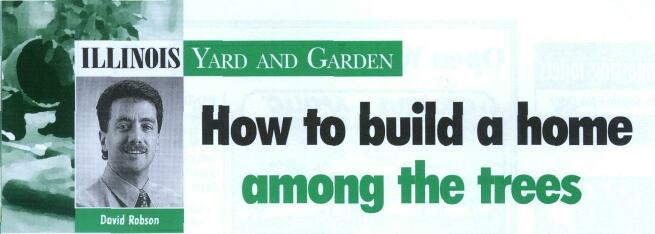 |
Home | Search | Browse | About IPO | Staff | Links |
 |
Home | Search | Browse | About IPO | Staff | Links |
|

True story: While poking around at one of the many central Illinois garden centers, someone came up to me and said, "Hey, why don't you write an article for that 'Electric Magazine' about all the idiots who build around trees and then expect them to live." (The trees, not the idiots, though I can't be sure of that.) He continued, "And then the trees die and they stand around like it had to be something like an insect that magically appeared overnight, or a disease that descended from the skies, or through some radical fundamentalist plot to destroy our natural forests, instead of the idiots who should not be allowed anywhere near a tree because they have so much money they want to build a house in the woods to commune with nature and the birds, yet don't have the foggiest notion that if you weren't meant to build a house next to a tree..." Well, I interrupted and said a deep long breath was in order, or he would end up in a pine box, and wouldn't that just be a little ironic then? Of course, some of my memory of the encounter might be different, but it did bring up a good point. Trees, houses and people don't go together as easily as you might think. This is especially true when you are talking about old trees, new houses and people with no common sense. I just can't fathom how some people get it into their mind that if they cut most of the roots around a tree, the tree will still live. Or if they add two feet of soil around the trunk of a tree, that water and air will magically just percolate into the soil at the level of that tree. I've watched subdivisions spring up overnight in wooded areas. Less than five years later, the trees slowly start flagging or dying from the top down. By that time, there isn't much to do or anyone to accept the blame. TRUE FACT 1: Trees need roots to absorb moisture and nutrients. Most of us know that. TRUE FACT 2: Most of the absorbing roots are smaller than a strand of hair, thus they are called root hairs. These root hairs are located at the outer reaches of the branches and beyond. This area is usually referred to as the dripline. These small roots feed into larger roots which feed into larger roots which feed into the trunk. TRUE FACT 3: Ninety percent or more of a tree's absorbing roots are within the top 12 inches of soil. TRUE FACT 4: Hair roots come and go, and can quickly regenerate if injured. Large roots cannot. You can cut off your hair without disastrous consequences; you can't cut off your head. TRUE FACT 5: Generally speaking, the roots on the south side of a tree feed the branches on the south side. However, and it is a big however, a tree does have the ability to reroute water and nutrients to some degree. TRUE FACT 6: It takes about an inch of water to penetrate eight to 12 inches into the soil. If soil is added over the root zone, the roots won't move up readily. That means more water has to be applied to reach the lower levels. It takes longer for air exchange, also. What does all this mean? First, if you are going to build in a forest, expect that some of the trees will die, and those will probably be the ones closest to the new house. Second, if you want to save a tree, don't build your house within six feet from the dripline. Third, if you have no choice and trees are in the way, do the least damage possible. Fence around the dripline of trees to keep construction equipment and materials away. Fourth, if you have soil from the basement, pay to have it hauled away. Don't spread it under trees. It doesn't help. It hurts. Fifth, if you have to cut roots, do it cleanly. Just like a cut on your skin, a clean smooth cut heals quicker with fewer problems than a ragged one. Sixth, if you have to damage roots, do it in the fall. There's less water stress on the tree, and roots regenerate faster in the cooler soils. Finally, choose a builder wisely. If someone says, "Sure, we can save all these trees," find another builder. Better yet, work with a certified arborist who can provide honest answers and actually knows about trees. Let the arborist work with you and the builder. And as always, call JULIE at (800) 892-0123 before you dig. David Robson is an Extension Educator, Horticulture, at the Springfield Extension Center, University or Illinois Extension. You can write to Robson in care of Illinois Country Living, P.O. Box 3787, Springfield, IL 62708. Telephone: (217) 782-6515. E-Mail; robsond@mail.aces.uiuc.edu 16 ILLINOIS COUNTRY LIVING www.aiec.org |
|
|